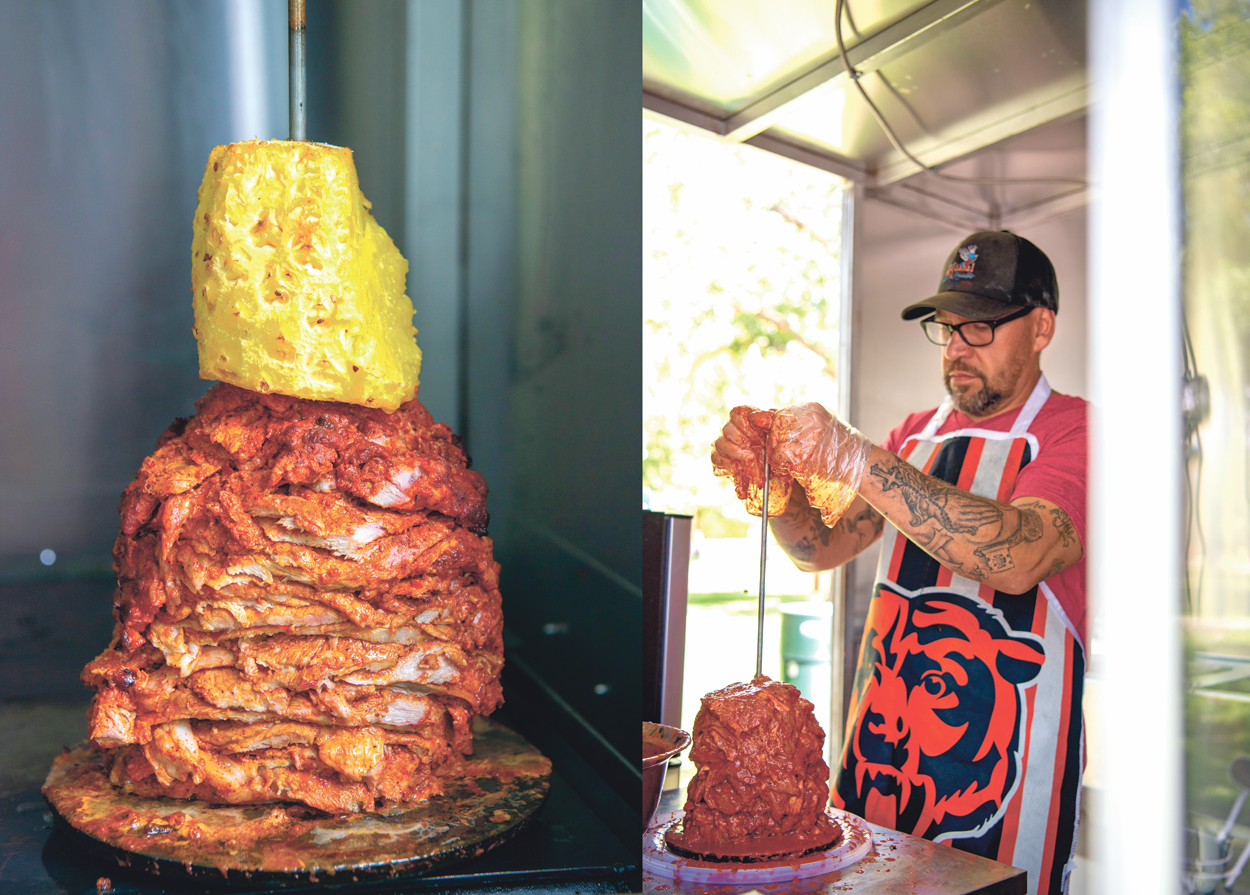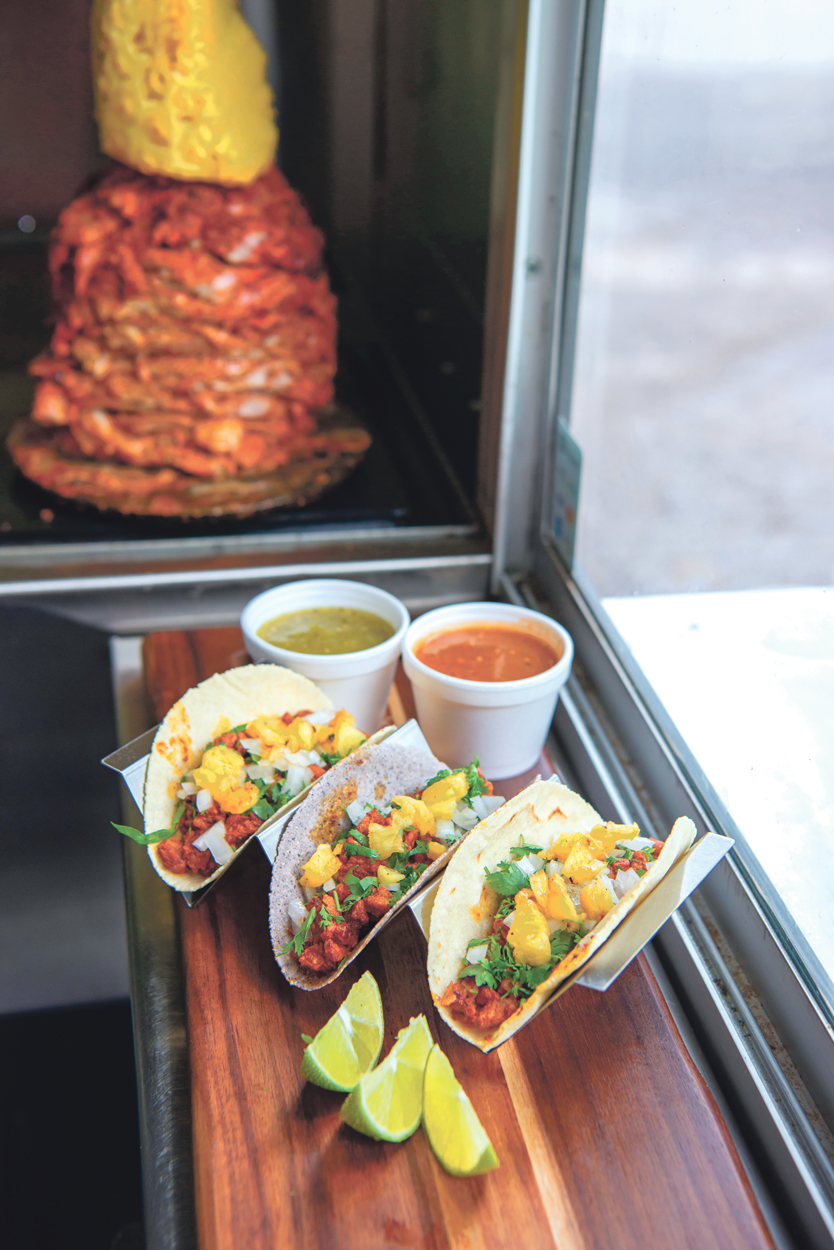In Search of a Better Taco al Pastor
by Briana Olson
photos by Ungelbah Dávila-Shivers

Early on in my quest for a seriously good taco al pastor, which involved trolling the streets of (mostly) Albuquerque for trucks and taquerias serving tacos al pastor and then eating so many tacos that I began to believe in such a thing as a taco overdose, I wondered if I’d embarked on a fool’s errand. I had yet to find a taqueria that used the traditional trompo, or vertical rotisserie, and of the places on my list, at least one had gone out of business. Chewing (and chewing, and chewing) on a mouthful of factory tortilla stuffed with pink cubes of pork, I considered more accessible pursuits, like reporting on the birria craze or tracking down well-made carnitas.
But no, I’d decided on a taco that is both elusive and ubiquitous—one that is served nearly everywhere, is almost always easy to eat, and is, almost as often, easy to forget. Maybe that’s why so many taco lovers never order them or don’t quite know what they are. “They’re not my favorite,” people told me, or, referring to quesobirria, “Is that the one you dip in the sauce?”
Tacos al pastor are often associated with Mexico City, where they likely evolved from the tacos árabes devised by Lebanese and Iraqi immigrants to Mexico, but I first encountered them in Xalapa, Veracruz. At one taqueria there, I watched, wide eyed, as the cooks slathered huge, thin pieces of meat with red adobo and then folded them onto a vertical spit in a way that reminded me of folding clothes. To prepare the tacos, they shaved roasted meat off the edges, crisped it up on the flat top, filled a freshly made corn tortilla, and topped it with cilantro and finely chopped pineapple. Salsa was almost (but never quite) superfluous.
I wasn’t looking for a replication of that experience—that would be impossible, for more reasons than the tacos themselves. In fact, the more tacos I ate, the less sure I became that I even knew what I was looking for—sort of like what happens if you set out on an afternoon of wine tasting and swallow all the wine instead of politely spitting it into the provided receptacle. Alternating bites from a taco at one truck on Bridge with bites from another, the distinctions were instantly clear—and, just as instantly, gone, traceable only in the red stains on my plate.
The trompo was an easy criterion to settle on. Pineapple was another. But sometimes what fell short was more difficult to see, or articulate. At one truck on Unser, the unexpected sides—refried beans with cheese, very good rice—overshadowed the tacos. Often, as at one spot on Airport Road in Santa Fe, the salsa was tastier than the marinade or the meat. “Son muy ricos,” one purveyor assured me after I asked whether the meat was prepared on a trompo (the answer was no).
At Tako Ten (which does use a trompo, but I managed to visit on an evening when it stood sparkling clean behind the register), the pork on the taco al pastor was tender, tasty, but it was overpowered by guacamole, and the fried chicken taco outshined it. My second trompo sighting was behind the no-nonsense lady taking orders at La Catrina on Juan Tabo—although it too was turned off. With outdoor temperatures approaching one hundred, I could sympathize, and the pork here, finished off on the griddle, was closer. I can do this, I thought, downing two loaded tacos in less than the space of a pilsner.
“These are the best,” my partner declared—unaware that he’d sampled only a fraction of the tacos I had—when we ordered from nearby Tacos la Mordida. The spit-roasted meat was lean, heavily marinated, and served with large chunks of pineapple and lots of cilantro in tortillas that, if store bought, had picked up some sauce and grease (and hence flavor) from the plancha. At El Cotorro, in contrast, there was little to no pineapple, but the pork was nicely roasted, more lightly and a touch more mildly seasoned than elsewhere. I had been trying to sidestep the importance of the tortilla, but El Cotorro makes their own, and it was while I was sitting on their patio that I realized I couldn’t not judge a taco at least partly by its cover.
All the places I’ve named make good tacos. And taste, of course, is subjective. But when I bit into a taco al pastor from Káahal Nuestro, I immediately knew that whatever I may have been looking for, this was it.
Káahal Nuestro translates as “our beginning” and refers to owners Raul and Manuela Perea taking the leap, when the pandemic hit, of leaving construction to start their own food business. When I asked why they decided to do pastor (their other standard taco offering is cochinita pibil, a Yucatán specialty), Manuela said simply, “We couldn’t find it.”
On a Monday afternoon at Rio Grande Park, Manuela shared memories of a taquero in Asunción, an hour from the small town in Chihuahua where she grew up. “I loved to watch him cut it,” she said, describing how he’d cut all the way down the huge trompo from the pineapple at the top and catch the meat in a tortilla.
“Mexico is all about the spices,” she said later, contrasting the complex blend of ingredients in the adobo for pastor to New Mexican red chile. Pasilla and guajillo are two of three chiles used in their recipe, which has a tangy scent while raw and acquires a more delicate, slightly sweet aroma as it slowly cooks. Achiote and cinnamon are also among the ingredients.
When I first tried their tacos, it was the array of flavor notes as much as the juicy, tender texture of the pork and the satisfaction of freshly made tortillas that led me to call them and ask to learn more about their process.
Their tacos al pastor are different from the ones I had in Veracruz, and probably different from the ones sold on Avenida Lorenzo Boturini in Mexico City. She and Raul hand-cut the meat, using shoulder and butt, massaging the smooth adobo into it before three hours of marinating. Their method involves the use of a spit, but with a somewhat unconventional approach (a secret I agreed to keep). Their tacos are the result not only of imitation, but mastery, by which I mean the ongoing practice of tweaking, tasting, listening, and tweaking again.
When it was time, they pressed tortillas and threw them onto the plancha, pointing at the puff that should occur when the tortilla is flipped. They packed me tacos to go. But I opened the box to study the results of their labor of love, and I realized I had nothing more urgent to do than eat these lovely tacos. I alternated bites with salsa roja (made with chiles including the fiery and not-easily-procured chiltepin), with salsa verde, and with the roasted pork all on its own. Within minutes, I’d eaten all four.











